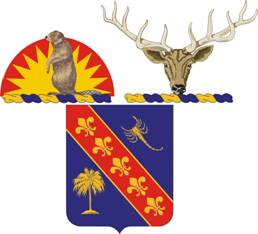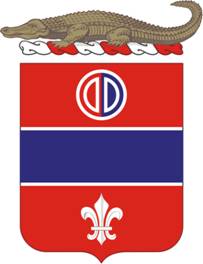
The 45th Infantry Brigade Combat Team ("Thunderbird") is a modular infantry brigade combat team of the United States Army headquartered in Norman, Oklahoma. It is a part of the Oklahoma Army National Guard.
The 150th Field Artillery Regiment is a field artillery unit in the Indiana Army National Guard.

The 5th Field Artillery Regiment was constituted as part of the Regular Army in January 1907. Individual battalions have lineages which date back further. Currently, it is a parent regiment under the U.S. Army Regimental System, with a single active battalion, the 1st Battalion, 5th Field Artillery, which is assigned to the 1st Brigade Combat Team, 1st Infantry Division at Fort Riley, Kansas.

The 179th Infantry Regiment ("Tomahawks") is an infantry regiment of the United States Army's National Guard.

The 17th Field Artillery Regiment is a field artillery regiment of the United States Army first formed in 1916.

The 77th Field Artillery Regiment is a field artillery regiment of the United States Army. First constituted 1916 in the Regular Army as a cavalry regiment. Reorganized in 1917 as field artillery and given its current designation.

The 157th Field Artillery Regiment (First Colorado) is a United States Army Regimental System field artillery parent regiment of the United States Army National Guard, represented in the Colorado Army National Guard by the 3rd Battalion, 157th Field Artillery Regiment, part of the 169th Field Artillery Brigade at Colorado Springs.

The 133rd Field Artillery Regiment is a parent field artillery regiment of the United States Army National Guard. It is currently represented in the Texas Army National Guard by the 1st, 3rd, and 4th Battalions.

The 86th Field Artillery Regiment is a inactive parent field artillery regiment of the United States Army, last represented in the Vermont Army National Guard by the 1st Battalion, 86th Field Artillery Regiment. Perpetuating the Vermont Light Artillery Batteries of the American Civil War and subsequent Vermont artillery units, the regiment was organized following World War II as the 206th Field Artillery Battalion in the Vermont National Guard. The 206th saw active service in Germany with the 43rd Infantry Division during the Korean War, and became the 124th Artillery, a Combat Arms Regimental System parent regiment, in 1959. Represented by the 1st Howitzer Battalion, 124th Artillery, the regiment was renumbered as the 86th Artillery in 1964 when the 1st Battalion became the brigade artillery battalion of the 86th Armored Brigade. The 1st Battalion served in that role with the brigade for much of the rest of its existence.

The 148th Field Artillery Regiment is a Field Artillery Branch regiment of the Army National Guard.

The 158th Field Artillery Regiment is a Field Artillery regiment of the Army National Guard.

The 1st Squadron, 180th Cavalry Regiment is a formation of the United States Army, headquartered in McAlester, Oklahoma. It is a part of the 45th Infantry Brigade Combat Team, Oklahoma Army National Guard and is one of the oldest units in the brigade.

The 1st Battalion, 279th Infantry Regiment is headquartered in Sand Springs, Oklahoma. It is a part of the 45th Infantry Brigade Combat Team, Oklahoma Army National Guard.

The 45th Fires Brigade is a modular field artillery brigade of the United States Army headquartered in Mustang, Oklahoma. It is a part of the Oklahoma Army National Guard.

The 116th Field Artillery is a regiment of the Florida Army National Guard. Currently there are two battalions; 2-116th FA is fires battalion for the 53rd Brigade Combat Team, and 3-116th (HIMARS) is part of the 164th Air Defense Artillery Brigade, both of the Florida Army National Guard.

The 107th Field Artillery Regiment is a Field Artillery Branch regiment of the United States Army. It has been affiliated with the Pennsylvania National Guard since its formation. It appears that the regiment last formally came into existence in June 1959, when the 107th Field Artillery Battalion was reorganized as the new Regiment's 1st Battalion in line with the Pentomic (ROCID) reorganization going on at that time.

The 103rd Field Artillery Regiment is a regiment of the United States Army. The only currently existing component is the 1st Battalion, 103rd Field Artillery Regiment, a unit of the Rhode Island National Guard. The regiment was originally constituted in 1917, but it descends from predecessor units dating back to 1801.

The Chatham Artillery is an artillery unit that has played a leading role in the history of the state of Georgia since the American Revolution. In 1776, Thomas Lee was authorized to enlist a provincial company of artillery for the defense of Savannah, the first such unit in Georgia's history. Commanded by Joseph Woodruff, they defended the right flank of American forces when the British attacked Savannah. They saw service in the Oconnee wars, The Embargo Wars, and The War of 1812. They were part of the force that occupied Fort Pulaski that opened the American Civil War, and served in and around Savannah and Charleston South Carolina before joining General Johnston's forces in Columbia, South Carolina. After the reorganization in 1872, they mustered out to the border with Mexico, to stop Pancho Villa's raids in the United States. They served with the "Dixie Division" in France during World War I, and landed on Normandy Beach on D-day plus 4 in World War II. They breached the Siegfried Line, and were at the Elbe River when the war ended. In 2005 they were mobilized again into federal service, as an element of the 48th Brigade Combat team serving in Iraq, part of Operation Iraqi Freedom. The Chatham Artillery was re-mobilized in 2009 to support Operation Enduring Freedom in Afghanistan, personally training Afghan Troops and Police Forces. They were demobilized in 2010 at Fort Stewart, Georgia. Today they remain in service, as a modular artillery brigade of the Georgia Army National Guard, the 118th Field Artillery.
The 118th Field Artillery Regiment is a field artillery regiment of the Georgia Army National Guard. The regiment's 1st Battalion is the cannon battalion assigned to the 48th Infantry Brigade Combat Team. It is one of several National Guard units with colonial roots and campaign credit for the War of 1812.

The 123rd Field Artillery Regiment is an active Field Artillery Branch regiment of the Illinois Army National Guard. The regiment's 2nd Battalion last served as a towed, 155mm cannon battalion assigned to the 169th Field Artillery Brigade, though administratively under the control of the 65th Troop Command.



















